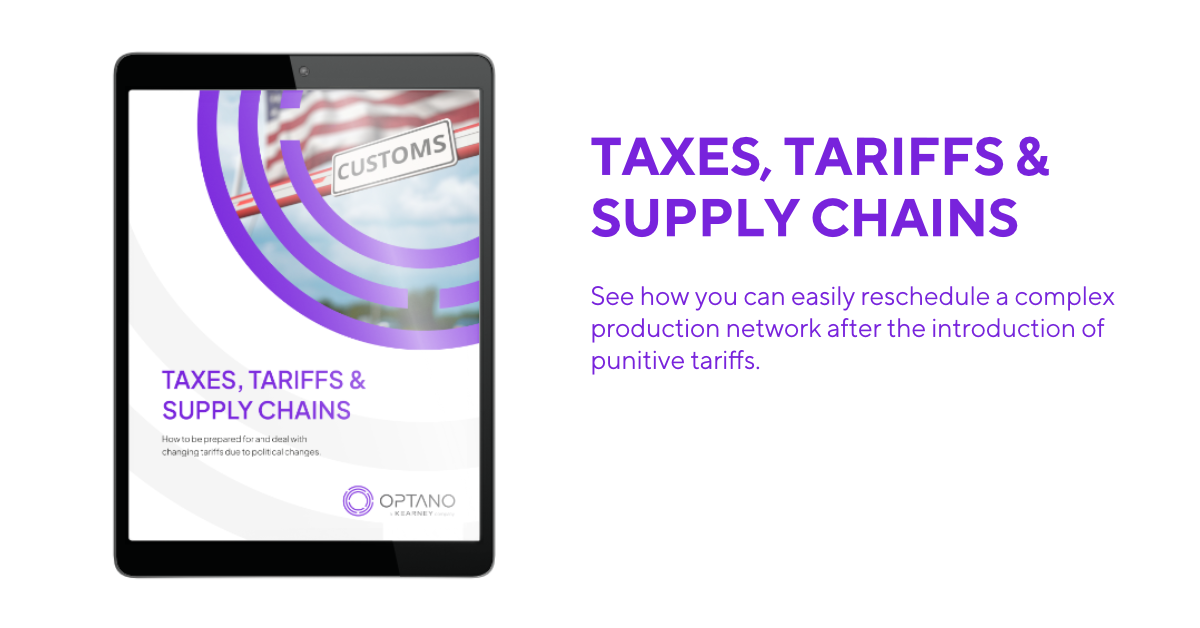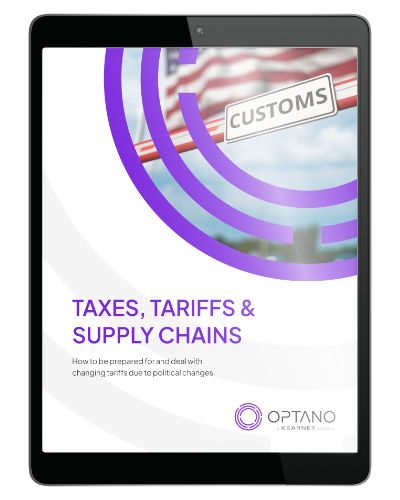Tariff increases put pressure on global supply chains
The international trade and economic policy environment has changed significantly in recent years. Geopolitical tensions and trade wars have added uncertainty. While new trade agreements are being signed, others are being canceled, and many countries are adjusting their tariff policies to protect their economies.
With Donald Trump back in office as US President, the situation has become even more acute. Trump plans to impose tariffs of more than 20 percent on imported goods. These measures, which primarily affect the automotive, chemical, machinery, and consumer electronics industries, are aimed at strengthening the U.S. economy and could lead to new trade conflicts.
In this blog post, we look at the broader implications of the tariff increases. We also present mathematical optimization techniques that can help companies adjust their strategies to ensure supply chain resilience and increase efficiency.
Tariffs have a direct impact on supply chains and networks
The current changes in the international trade landscape have far-reaching implications for the future security of supply chains and the organization of production and distribution networks. Companies must adapt to these dynamic conditions to ensure their competitiveness in an increasingly complex global marketplace.
Impact of tariffs on procurement
Current trade policy developments are creating significant sourcing challenges for companies as increased import tariffs lead to significant cost increases. The additional expenditure in the form of tariffs on imported raw materials and components is a burden on company budgets and has the potential to increase prices for end consumers. This jeopardizes the competitiveness of companies and forces them to rethink their sourcing strategies as supplies from certain regions become less attractive due to increased tariffs.
Impact of tariffs on the production network
The production of components and end products is as critical to a company’s economic success as the procurement of materials. Tariffs therefore have a significant impact on existing production networks. Faced with increased costs, companies are being forced to rethink their production strategies and reorganize their networks. Many are considering relocating production to countries with lower tariffs or more favorable trade conditions to optimize their overall costs.
Finding the balance for a long-term increase in EBIT
Overall, a volatile market environment with rising tariffs is putting significant pressure on companies’ cost structures and is having a profound impact on global supply chains. These challenges are forcing companies to fundamentally rethink their sourcing, manufacturing, and distribution strategies. The goal is to reduce end-to-end costs while developing strategic resilience that ultimately improves long-term EBIT.
Changes in production and distribution networks have a significant impact on efficiency and costs. New regulations and logistical challenges require a balance between duty savings and operating costs. This makes it difficult to adapt to favorable tariff and duty structures and increases the complexity of supply chains.
Mathematical optimization as a solution to the challenges of current tariff policy
Given the complexity of this problem, it is almost impossible to find a true optimum by considering all the dependencies in manual planning, such as Excel. Mathematical optimization offers a critical advantage in meeting the challenges posed by current trade policy developments by allowing companies to take a holistic view of a large number of constraints. The use of mathematical models makes it possible to make scientifically sound decisions, allowing companies to adjust their strategies in a targeted manner.
More interesting articles
Protect Supply Chains from Trade Wars and Geopolitical Tensions with OPTANO
In an era of ever-changing international trade conditions and regulatory requirements, innovative planning software such as OPTANO provides the ability to accurately analyze the impact of duties and taxes on overall costs and profitability. With OPTANO, companies can use mathematical methods to comprehensively evaluate customs policies and their potential impact on the supply chain and act proactively.
Model the entire supply chain - including tariffs
The OPTANO solution for network optimization makes it possible to transform the existing supply chain into a mathematical model that structures the various components easily and without in-depth mathematical knowledge. In addition, the effects of tariff changes can be easily taken into account by making adjustments to individual or multiple locations with just a few clicks.
Adjusting the sourcing strategy
Because of the higher tariffs, it is important to carefully consider the sources of raw materials and components. Some raw materials are only available from certain countries, so the tariffs must be accepted. For other materials, geographic diversification can be considered.
OPTANO’s network planning solution helps by allowing you to firmly define specific suppliers while offering a selection of different potential suppliers. The underlying mathematics finds the optimal supplier constellation, taking into account the overall effect on the network. In this way, geographic diversification can help mitigate the negative impact of rate increases and make sourcing strategies more flexible.
Adjustment of the production network
In the face of rising tariffs, companies are often forced to rethink their production strategies, which may include relocating production facilities, although such changes are not feasible in the short term.
Alternatively, companies can adjust their product mix at existing sites in the medium term. For example, the planning of production facilities in the US could be optimized so that additional new variants are introduced there and the quantities of existing variants are reduced accordingly. If it is necessary to add variants from other locations, OPTANO’s network optimization solution enables precise evaluation of these trade-offs in order to make the best possible decision.
Scenario comparisons for best decisions
A key benefit of OPTANO’s network optimization solution is its ability to comprehensively analyze the impact of different scenarios. Scenario comparisons and clear visualizations allow users to quickly evaluate different strategies to determine the optimal solutions for improving networks and supply chains. As a result, companies can make informed decisions about how to reallocate resources and adapt their sourcing and distribution processes.
These optimizations include product plan allocation, make-or-buy options, and material flow adjustments.
Transparency for resilience
Another outstanding feature of OPTANO is the transparency it provides through consolidated data analysis. Companies get a clear overview of their capacities, volumes and (customs) costs. This transparency improves their risk management and strengthens their decision making. Comprehensive analysis enables early identification of potential supply chain disruptions and provides the basis for better and more informed decisions.
OPTANO for future-proof supply chains
OPTANO enables companies to effectively protect their supply chains against trade wars and geopolitical tensions by providing decisive advantages in analysis and planning. Precise modeling of the entire supply chain enables rapid response to changes in customs legislation, which in turn optimizes sourcing conditions and production strategies. As a result, companies can not only better manage potential risks from customs changes, but also strengthen their resilience to external challenges.
Do you already know our factsheet on this topic?

Global supply chain executives face significant challenges as a result of current political developments. Changes in trade policy, such as rising import tariffs, require adjustments to sourcing strategies. Supply chain managers need to make decisions quickly to ensure the future viability of their supply chains. OPTANO provides you with a tool that allows you to react flexibly to unforeseen events and optimize your supply chains. In this factsheet, we use a fictitious use case to show how OPTANO can be used to easily reschedule a complex production network following the introduction of punitive tariffs.
To obtain our factsheet, all you need to do is enter your contact details in the space below. A pop-up window will then open to download the whitepaper. Please note that by providing us with your email address, you agree that we may contact you on this topic. You may revoke this agreement at any time by contacting privacy@optano.com.







